Montreal-born voyageur Jean Baptiste Brulé and his family settled in Sooke around 1850, setting up a homestead at the foot of the mountain that now bears his name, rising up beside Mount Manuel Quimper above the Sooke Inlet, only a short drive from Victoria. The views down over the inlet towards East Sooke Park and the distant Olympic mountains are magnificent, though the actual hike up leaves something to be desired. The first half of the hike up Mount Brulé follows an old logging road that cuts straight through Sea to Sea Regional Park, offering little variation in elevation or scenery. Eventually singletrack breaks off from the logging road and leads its way up the mountain, sometimes a little steeply. The trail is shared with mountain bikers and much of it is unfortunately eroded, with the thin layer of soil being swept away, exposing the stone below. Some sections of the trail would be slippery when wet.
Most unfortunate of all is the viewpoint near the top of Mount Brulé, where a lot of the delicate grass and moss has been trampled and the soil turned into mud puddles. Whether you’re on a bike or on foot, take care where you step, especially at the summit, as the vegetation is incredibly fraile and much has already been destroyed. In my photos at the viewpoint I was able to carefully step only on exposed stone without disturbing the plants. Please do the same.
Despite my few issues with the hike, the short duration and exceptional views are a winning combination that outshine any negative aspects. Mount Brulé is a fantastic hike near Victoria for those looking to mix things up from the usual Victoria hikes in Goldstream and Gowlland Tod, and a great option for those looking to begin exploring hikes in the Sooke Hills.
Continue reading this blog post for everything you need to know to experience the Mount Brulé hike on Vancouver Island for yourself, including distance, elevation gain, how to get there, the best time to visit, and lots of photos of my experience.
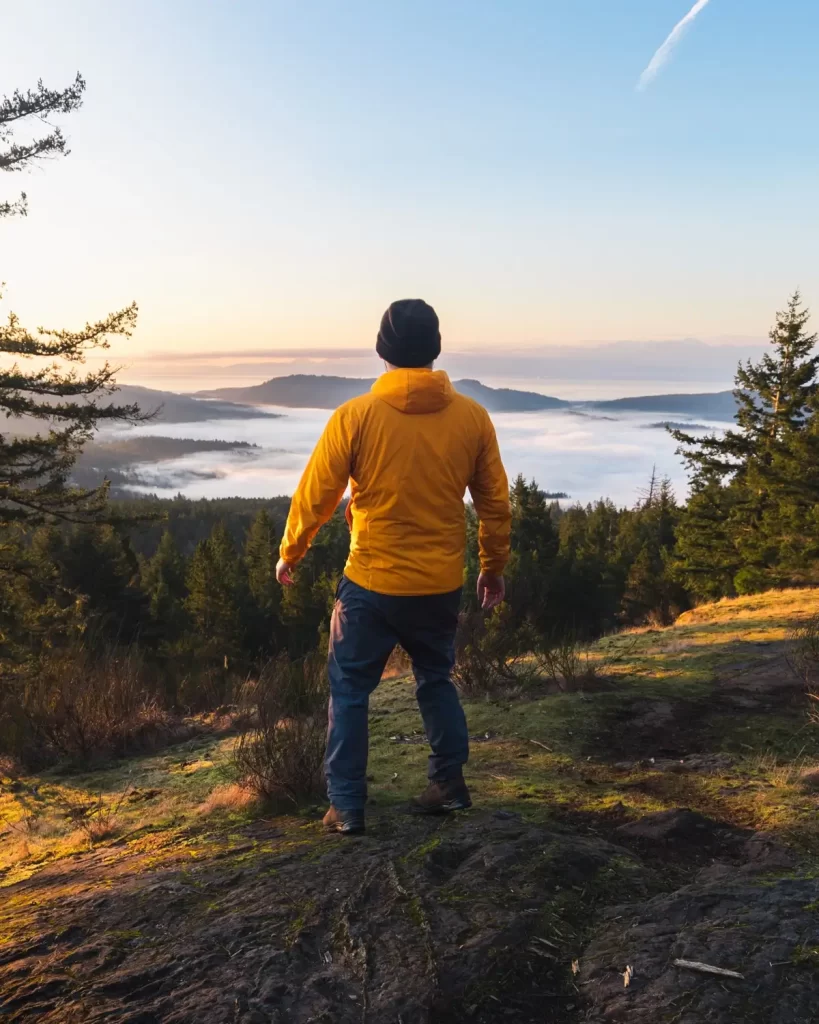
When hiking it’s important to avoid harmful practices such as disturbing plants or rock-stacking, or removing any natural object from flowers to rocks, as it’s important to leave the environment as natural as possible for the animals and for fellow hikers to enjoy in perpetuity. As many flowers as there are, there are few enough that if we all took one, then there wouldn’t be any left. Take only photos, leave only footprints.
If you haven’t heard of Leave No Trace principles, they’re also really essential to read up on before heading anywhere into the outdoors in general. Following these important principles basically means doing your best to leave beautiful places like Mount Brulé as good (if not better) than you found them, both for their preservation and for the enjoyment of other visitors.
Mount Brulé Round Trip Details
Distance: 6 KM / 3.7 MI
Elevation Gain: 311 M / 1020 FT
Hiking Time: 1.5-2 HRS
Hiking & Safety Tips
- Prepare for the possibility of wildlife encounters. There are almost no grizzly bears on Vancouver Island, but black bears are still common. Bear bells are proven to be an ineffective bear deterrent, and are even actively discouraged by Parks Canada. The best way to let bears know you’re around is simply to use your voice. Make sure to keep a respectful distance from wildlife and never feed the animals. It may seem kind but it doesn’t just kill wildlife and put people in danger, it’s also in many cases illegal.
- Research current trail conditions and make sure you are well-informed about the route before you leave, and assess if it is within your capability. Be aware of what time it gets dark and check the weather forecast. Make sure to tell someone where you’re going and when you expect to return. Every year as more and more people try hiking for the first time, the number of rescues goes up. Being prepared is the best defense.
- Pack everything you need for a successful hike, including enough water and energy-rich snacks. Remember to pack out everything you pack in though – don’t expect to find a convenient garbage can halfway up the trail. Bring appropriate layers (remember you’ll warm up once you start hiking) and sun protection. Hiking poles may be helpful but are not required. In addition to not leaving any garbage on the trail yourself, I highly recommend bringing a garbage bag and collecting any trash that you do see on the trail. You’re guaranteed to make the hike up Mount Brulé a more enjoyable experience for the next person.
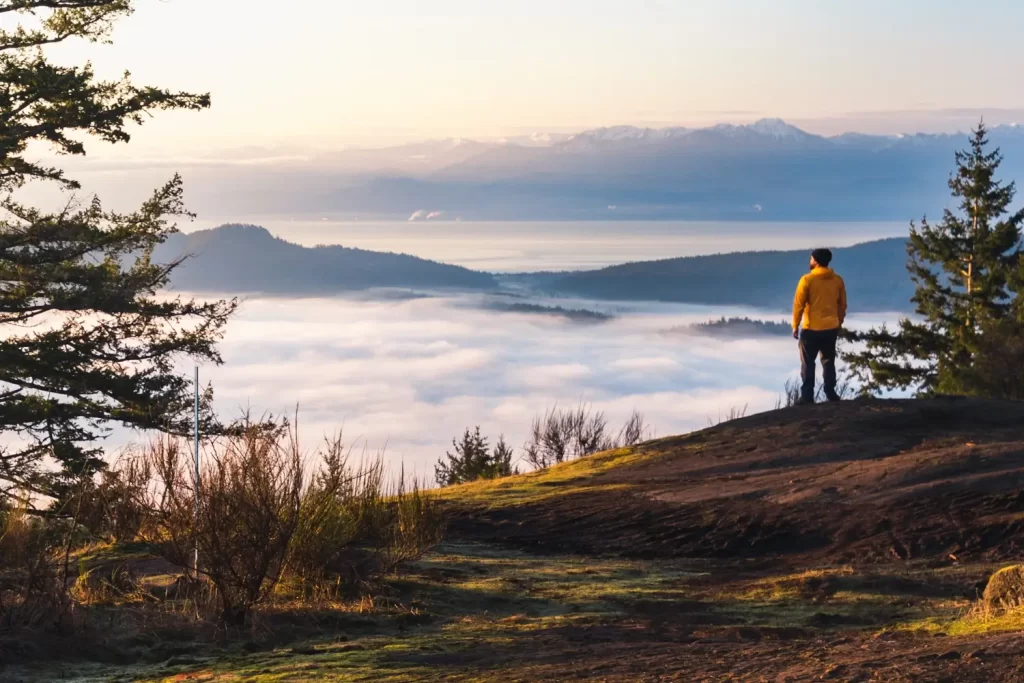
How to Get to Mount Brulé Trailhead
The Sea to Sea Regional Park parking lot and Mount Brulé trailhead is about forty minutes from Victoria in Saseenos. While driving along Sooke Road, after passing the Esso and Daniel’s Market on the left, take the enxt right turn up Harborview Road. Drive straight for a couple of minutes and you’ll find the parking lot at the end of the road. A sign says the park is closed from sunset to sunrise and the gate locked, but I found the gate unlocked an hour before sunset, giving me enough time to get up Mount Brulé before the sun came up.
Click here to open the exact trailhead location in Google Maps.
Hiking Mount Brulé
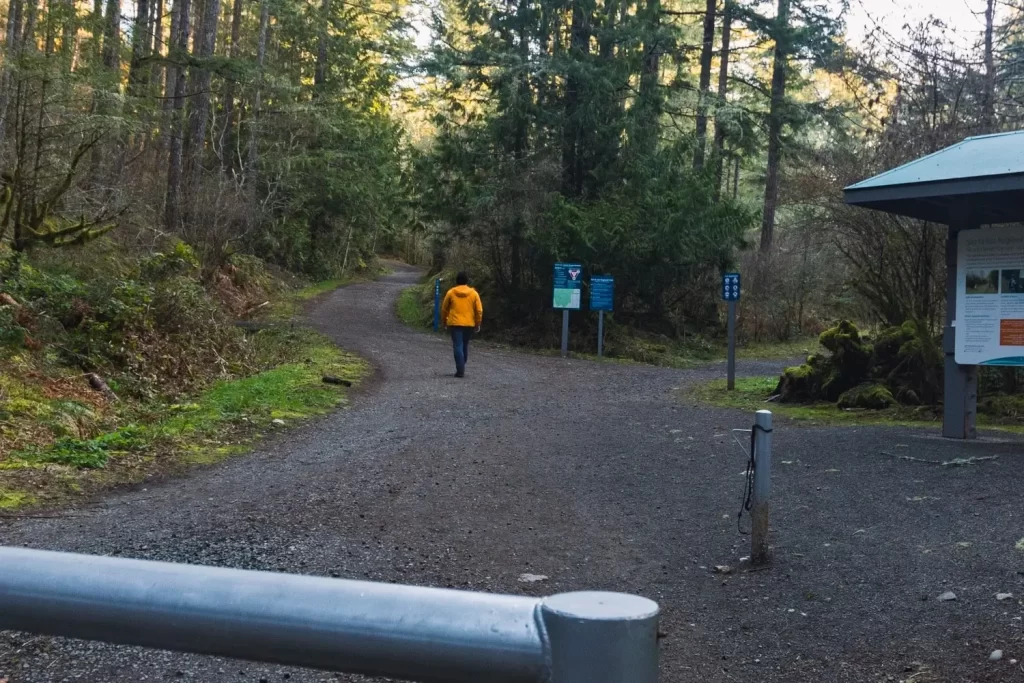
Setting off from the parking lot, following the old logging road straight through the woods towards Mount Brulé
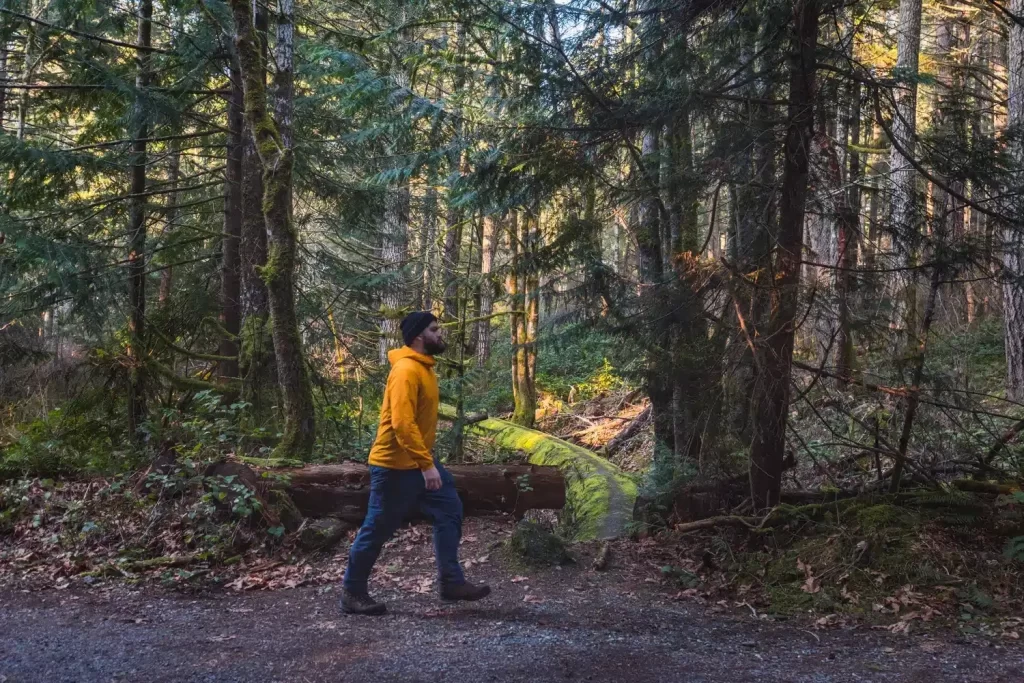
The road crosses the old Sooke Flowline, a four kilometer-long pipeline that once provided water to Victoria from the Sooke Reservoir.
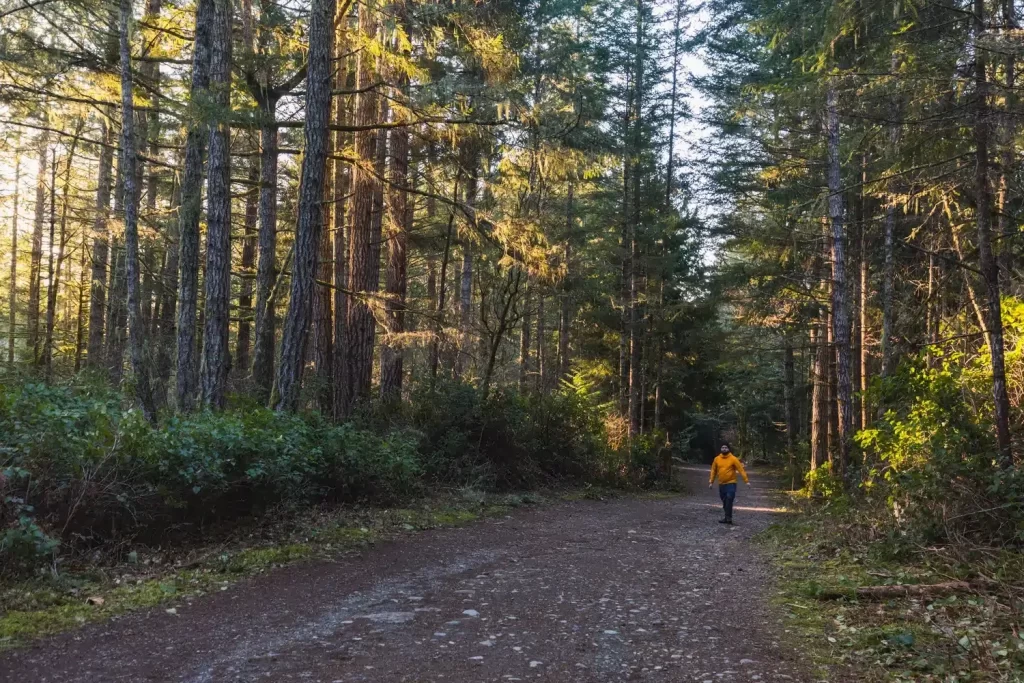
Expect little as far as views while walking along the old logging road. Fortunately it goes by fast.

A couple of roads break off to the left. Ignore them, though this is almost at the turnoff for the singletrack.
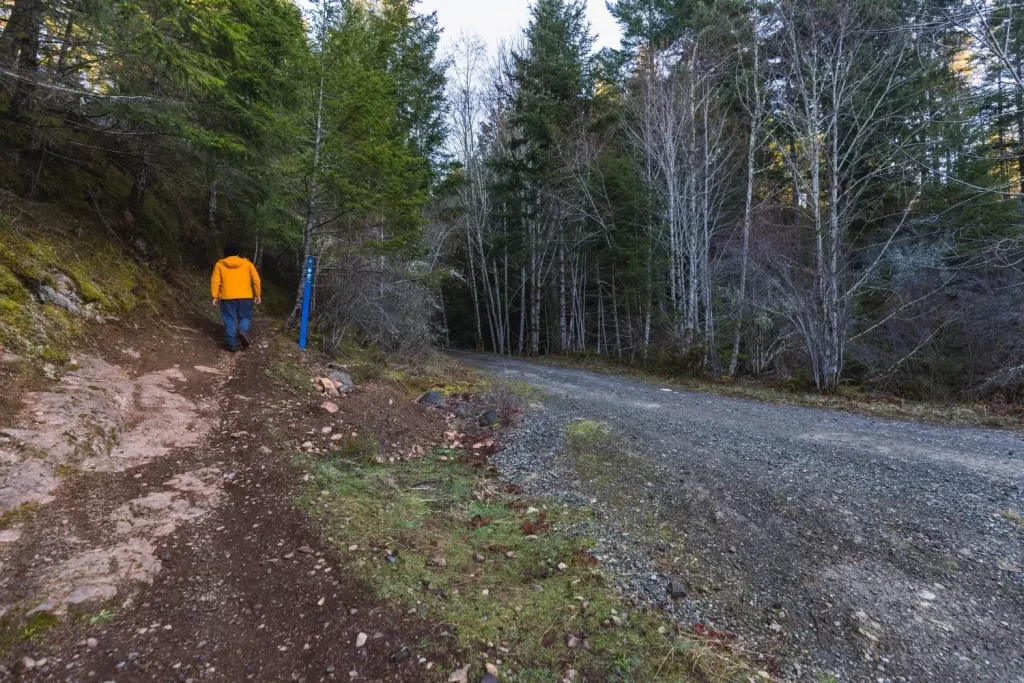
The singletrack breaks off from the logging road. The sign calls the trail Stonecrop 1.
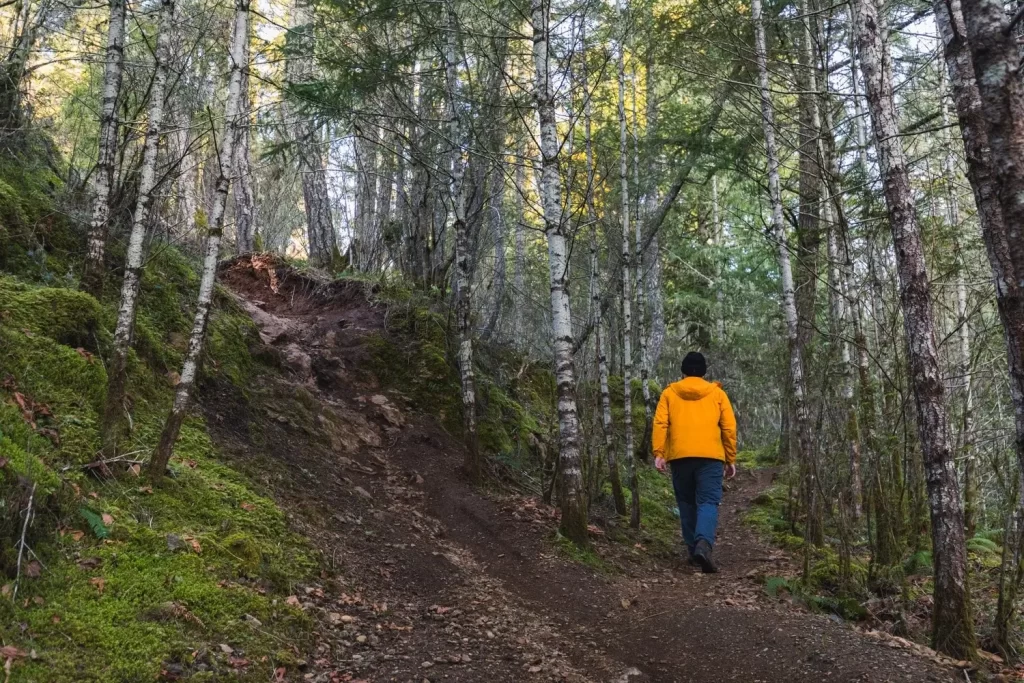
Pretty immediately there’s a fork, with the left being a bit steeper than the right. The trails reconnect in a minute so it doesn’t really matter.
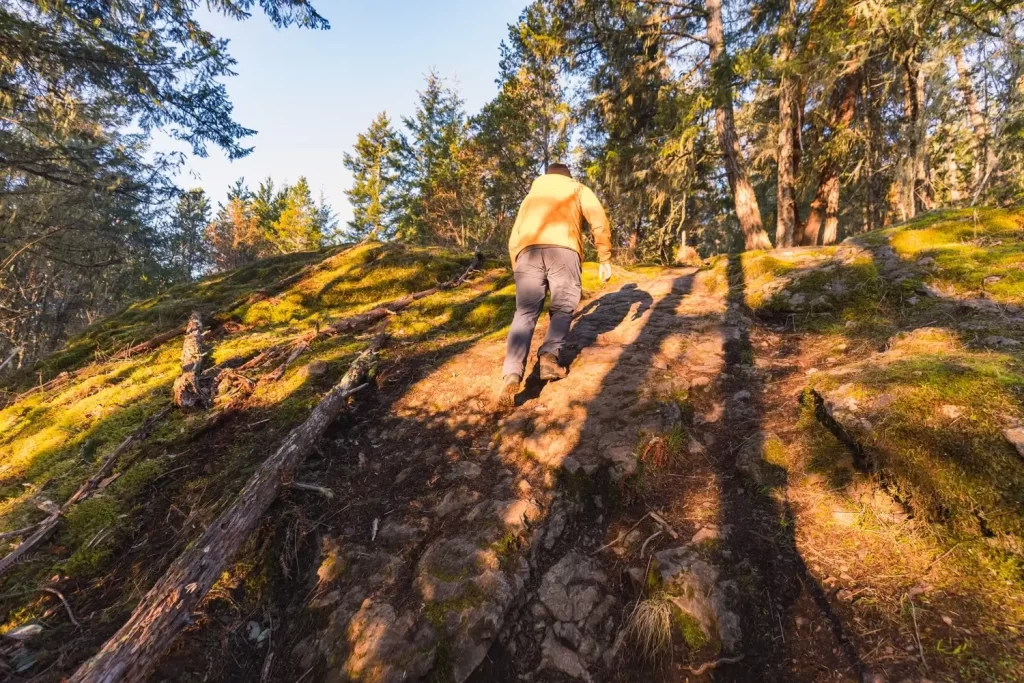
The thin layer of soil carpeted by moss has been completely swept away, leaving steep rock.
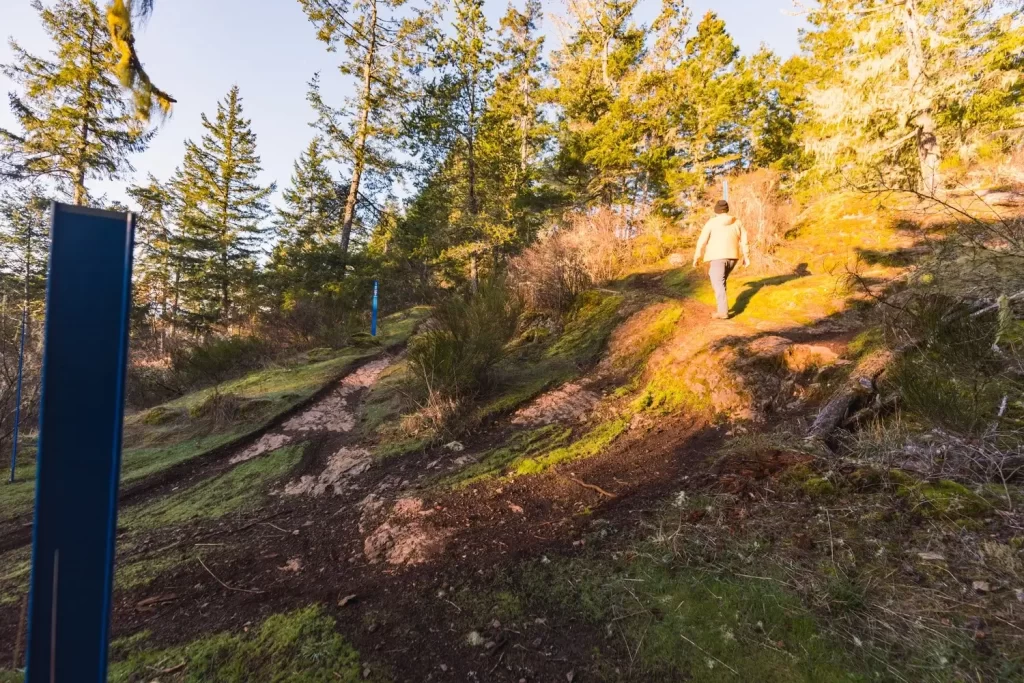
An important intersection. Head right up the rocky hill. Don’t follow the more obvious trail at left with the blue signpost.
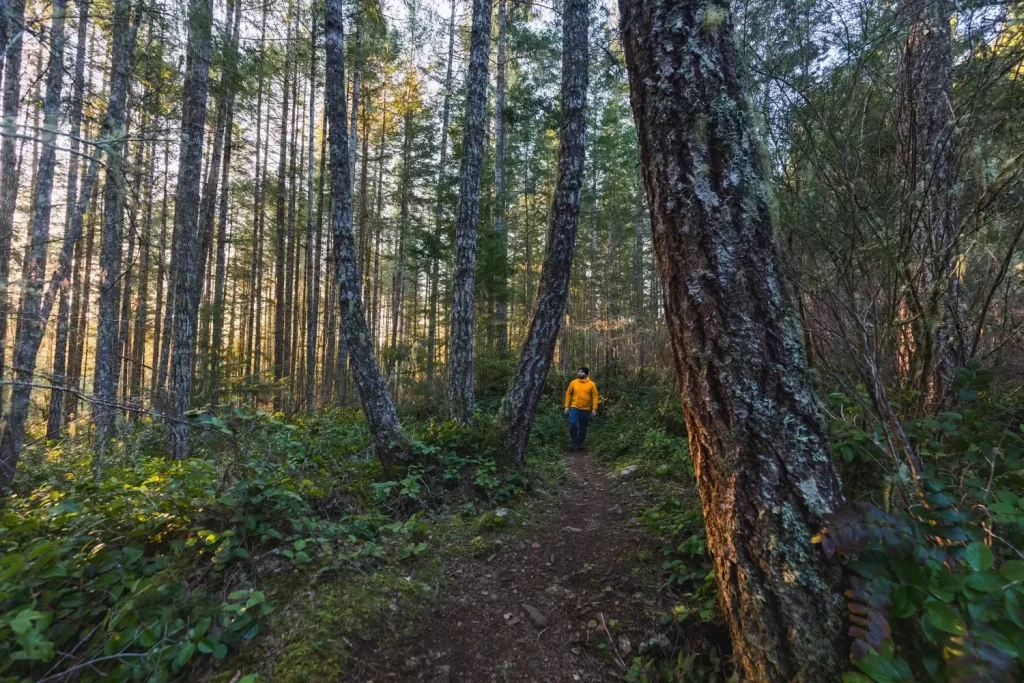
The trail was clearly designed for cyclists, not hikers, as it snakes around and up and down a lot of small hills.
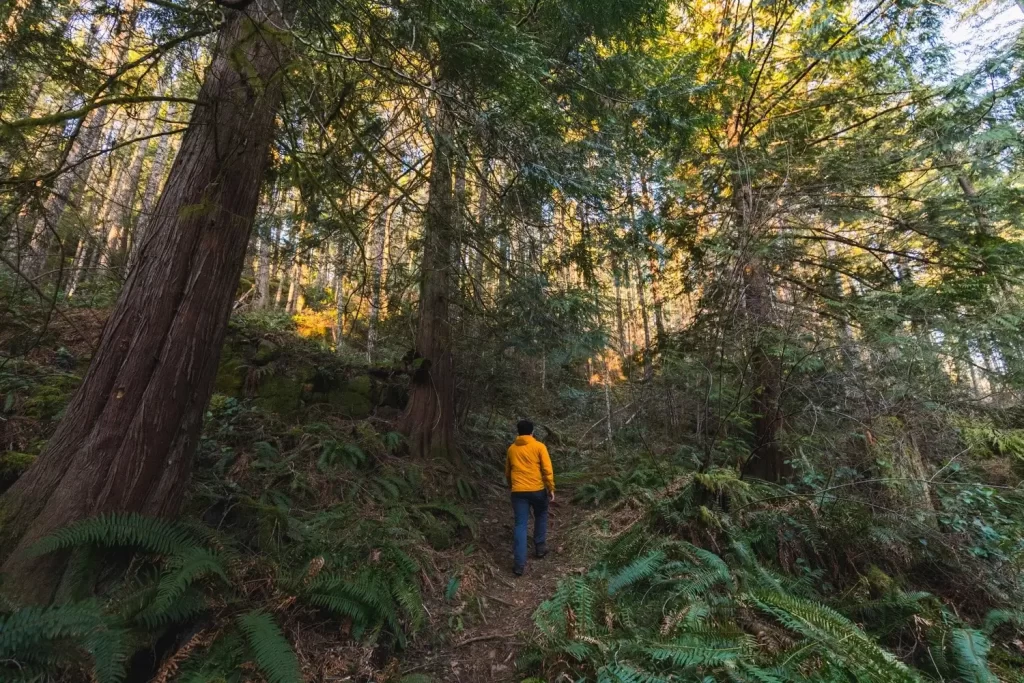
Fortunately, as the trail progresses the forest becomes more attractive.
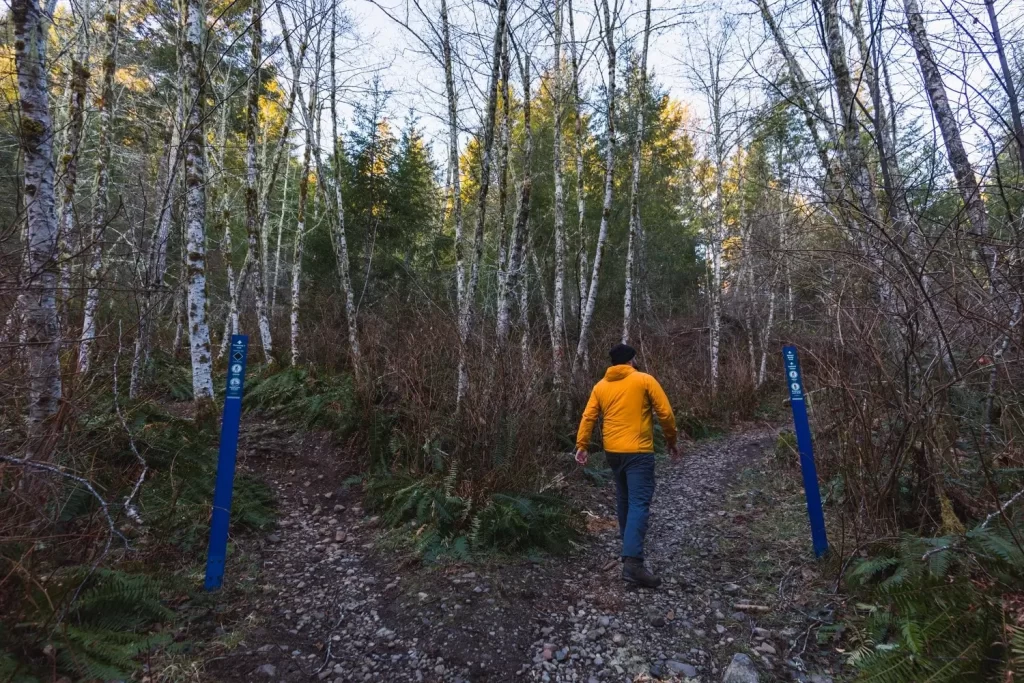
A quick snap turn to the left onto the Mount Brulé trail.

The trail is a bit rocky at times, but efficiently makes its way up to the top of Mount Brulé.
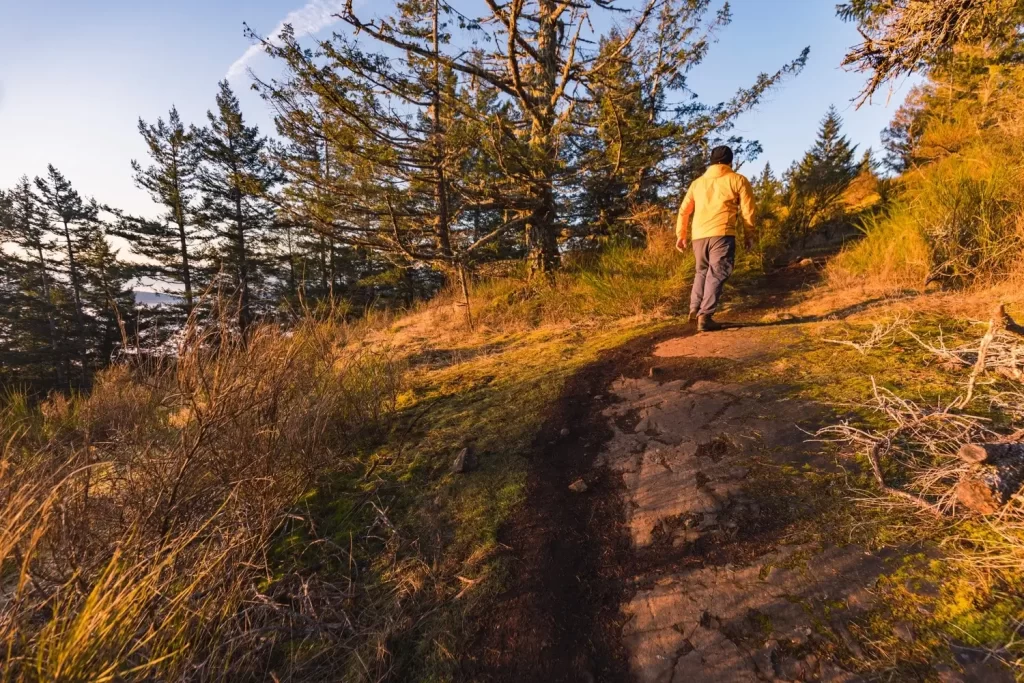
Views near the top starting to appear through the trees at left. Note how all the dirt is being swept off the trail from traffic. Make sure to stay on the trail to avoid widening it unnecessarily.
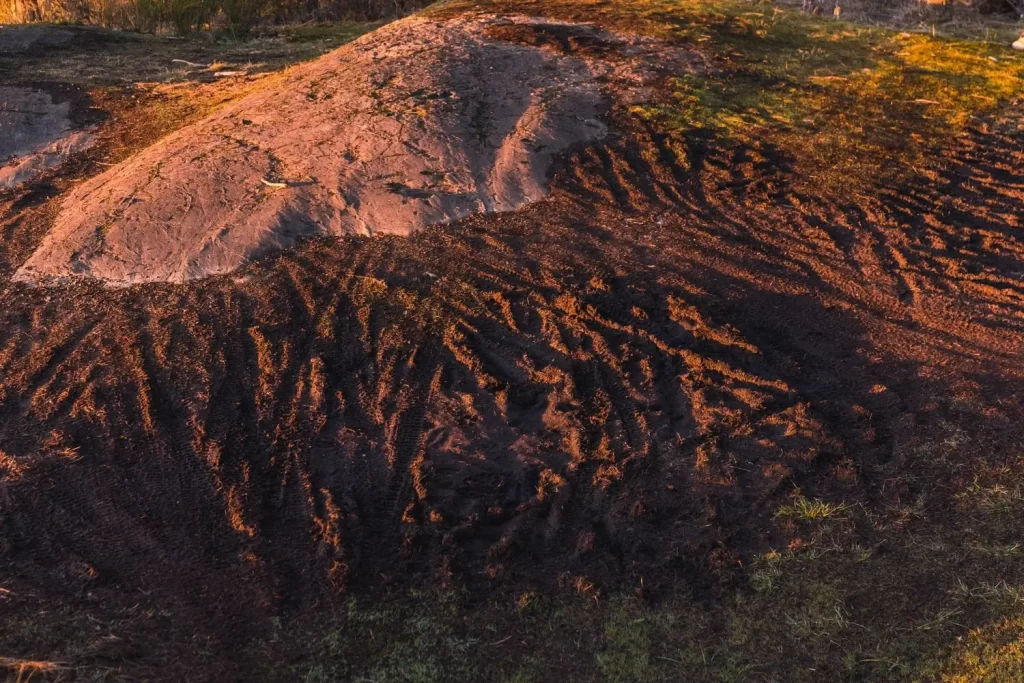
Sadly careless bikers have plowed the soil at the viewpoint. This is why it’s so important to watch where one steps, and try and stay on the exposed rock to limit future damage.
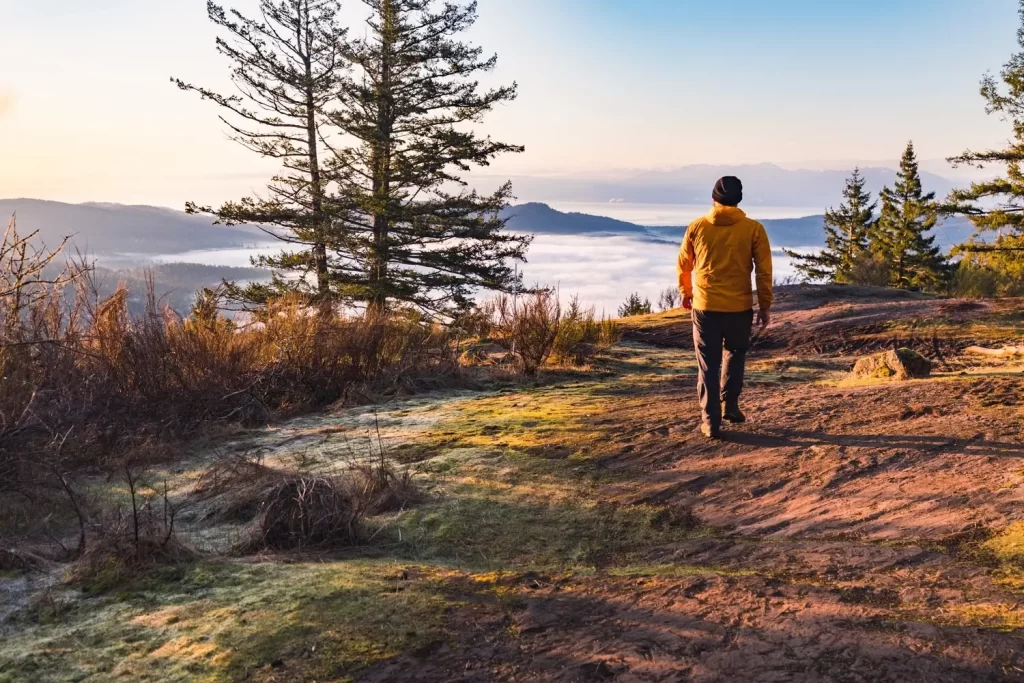
Spectacular views over the Sooke Inlet. The Olympic Mountains in the distance.
Recommended Hiking Gear



Water is a must whenever I’m hiking, especially if the sun is going to be out. My favourite water filter I’ve used is the Katadyn BeFree 0.6L, which unlike other water filters I’ve used packs up really small and lightweight. For hikes where I know there won’t be any readily available water sources along the way, I make sure to bring my own. The Hydrapak Stow 1L bottle is my go-to, for the same reason that it’s made of a soft plastic that folds up and doesn’t take up any more extra space than necessary in my pack. Finally, Aquatabs are another great option for purifying water, with one tablet being suitable for one litre of water. I previously used the Grayl water filter while travelling internationally, and though I found its hard body more convenient for day to day use and easier to drink from, it has a little too much bulk for my fast-and-light style of hiking.



The secret to all my photos of gorgeous sunset and sunrise mountaintop views? A lot of hiking in the dark. And let me speak from personal experience when I say that the last thing that you want to happen when hiking is to be caught in the dark without a headlamp. I used the Black Diamond Spot 400 for years and it worked great – until I lost it on top of a mountain somewhere. The only downside to it was having to worry about the batteries dying, though there’s also a slightly more expensive version that has a rechargeable battery. Nowadays I’m using the Petzl Actik Core, which is a bit pricier than the more budget-friendly Black Diamond, but is also brighter, more comfortable (in my opinion), and has a hybrid power system that is rechargeable but can also take AAA batteries if needed.
You won’t see me using trekking poles on shorter hikes often – but on long hikes and backpacking trips, as well as certain scrambles, they are an absolute lifesaver. I’ve invested in a high quality ultra-lightweight pair of MSR DynaLock Ascent carbon poles which, while pricey, I don’t regret one bit. If you’re not entirely sure how much use you’re going to get out of a pair of trekking poles, the best budget-friendly option would be the Trekology Trek Z 2.0. Amazon does sell a lot of cheaper Made in China-style trekking poles for cheaper, but these usually are much much heavier and not worth buying.
All the best and most long-lasting cables and power banks I’ve ever owned have been Anker. I once had a phone cable from them that lasted me over three years of daily use! That’s why I keep an Anker PowerCore Essential 20K power bank on me. Like many people I use my phone for a lot of stuff when hiking (checking in with family, using online maps, taking photos, flying my drone) so I like to be prepared for that low battery warning by having a backup power source on me just in case.



The only socks I ever buy for myself are from Darn Tough, and I almost always make sure to wear them when hiking. After years of having no problems only wearing these comfortable and rugged socks for hikes, I accidentally wore a pair of no-name socks on a hike last year and ended up with blisters on both feet. Safe to say I’m back to sticking with the Darn Tough. And the best part? They have a lifetime guarantee, meaning that if they ever wear out you can send them back for a brand new pair. For hiking footwear I go between a pair of lightweight approach shoes for quick and dirty mountain ascents or anything involving scrambling and more heavy-duty boots for longer treks. I’ve worn a couple different versions of the lightweight but super durable Arc’teryx Konseal FL 2 approach shoes for a few years now and am very impressed with the durability. I also really like the thick toecap that keeps me protected every time I stumble into a root or large rock. For longer, tougher, or muddier treks I rely on my LOWA Camino EVO GTX, which I find insanely comfortable and made of very high quality.



I wear my Ar’teryx Gamma Lightweight Pants on every single hike I go on, and on many days when I’m not hiking. After several years of abuse they are still holding together extraordinarily well, with only a few small holes from where I’ve fallen down and some slight stains from being repeatedly coated with mud. They’re lightweight, breathable, and super comfortable. For lightweight and breathable hiking tops I’m a big fan of both the Patagonia Capilene Shirt and the MEC Core Shirt. My Arc’teryx Squamish Hoody shows up in a lot of my photos. It’s super lightweight and packable, and does a great job of cutting the wind while also being pretty breathable. I also have an Arc’teryx Atom Hoody and Arc’teryx Beta LT that I pull out for cooler or wetter conditions.
I hope you enjoyed this guide to hiking Mount Brulé in the Sooke Hills! Feel free to leave any questions in the comment section below or to contact me directly via social media.

Just wanted to say I love your blog and am very thankful for your great directions and recommendations. I most of all love how you try to get everyone to cherish and take care of the land for everyone else to enjoy. Cheers!